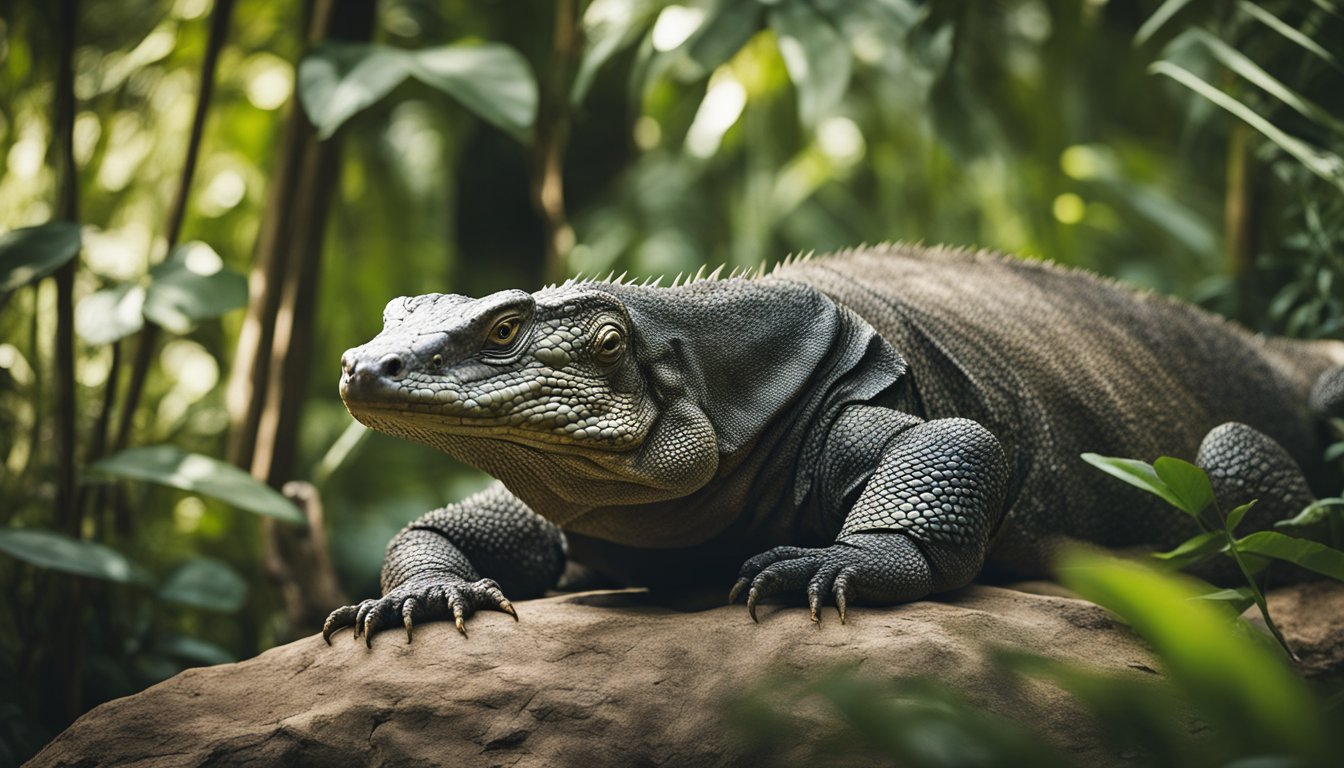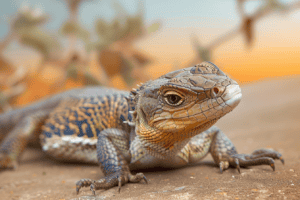Among the rugged landscapes of Indonesia’s islands, there roams a creature that seems to belong to a different age, a time when dinosaurs were the masters of the earth.
The Komodo dragon, the world’s largest lizard, commands the ecosystem of a few volcanic islands in Southeast Asia.
With their hefty, muscular bodies that can grow up to 10 feet long and weigh in at over 150 pounds, these formidable reptiles are a sight to behold.

The lifestyle of Komodo dragons is as fascinating as their daunting appearance.
They are the top predators in their habitat, showcasing a variety of behaviors that have captivated scientists and nature lovers alike.
From their unusual method of hunting to their social interactions, every aspect of the Komodo dragon’s existence speaks to an intricate balance of power and survival.
They feast primarily on carrion, but don’t let their scavenging nature fool you; these lizards are skilled hunters with a strategic approach that allows them to take down prey much larger than themselves.
Imagine a life on a tropical island with beautiful beaches and lush forests, but instead of lounging, you’re tracking scents with your long, forked tongue or speeding up to 12 miles per hour to catch a meal.
That’s the lifestyle of a Komodo dragon. Highly adapted to their environment, they have evolved to dominate the food chain.
Their sense of smell is so keen that they can detect a meal up to 6 miles away, and they have a bite famously known to harbor bacteria, making their hunting both efficient and deadly.
As the dominant predator in their range, they play a crucial role in maintaining the health of their island ecosystems.
Discovering the Komodo Dragon
Let’s journey to the past and unveil the secrets of the Komodo dragon, the largest lizard on the planet.
They carry a heritage that stretches back millions of years and exhibit features that seem almost otherworldly.
Origins and Evolution
The Komodo dragon, known to scientists as Varanus komodoensis, traces its lineage back to a group of lizards in Asia.
Over millions of years, their ancestors migrated southward, eventually reaching the Indonesian islands.
Evolution shaped them into the giants we see today, a process known as island gigantism.
They’re believed to have diverged from their smaller ancestors approximately 4 million years ago, and fossils similar to Komodo dragons date back to even earlier periods.
Physical Attributes
Komodo dragons are formidable creatures, with adult males averaging about 2.6 meters in length and weighing around 91 kilograms, while females are a bit smaller.
They possess a sturdy, muscular build, equipped with powerful legs that can propel them at speeds of up to 20 kilometers per hour in short bursts.
Their skin is tough and reinforced with bony plates called osteoderms.
Komodo dragons have a sharp sense of smell, using their forked tongues to sample the air and locate prey.
Their serrated teeth and venomous bite make them skilled predators.
With a large, muscular tail, they can defend themselves or attack prey with powerful whips.
Each feature of the Komodo dragon tells a story of survival, adaptation, and the raw beauty of nature’s design.
Through their unique evolution and impressive attributes, these remarkable lizards have become an iconic symbol of the wild and mysterious places they inhabit.
Explore further, and discover how these living dinosaurs dominate their ecosystem.
The Komodo Habitat

Imagine wandering through a remote and rugged landscape where the world’s largest lizards, the Komodo dragons, feel right at home.
These impressive creatures have adapted to a unique habitat that supports their large size and predatory lifestyle.
Now, let’s get up close and personal with the islands these giants call home.
Geographical Range
The Komodo dragon has an exclusive geographical footprint. They reside primarily on a handful of Indonesian islands.
The key islands include Komodo itself, also home to the eponymous Komodo National Park, Rinca, Gili Motang, and Flores, among others.
While their presence used to be more widespread, their current range is limited to these areas, making their habitat highly precious.
Have you ever wondered how living on these islands influences their daily habits?
Island Ecosystems
Their island ecosystems provide a rich tapestry of terrains, varying from dry open grasslands to dense forest patches.
The Komodo dragons have these areas to themselves, with little to no large mammal competitors.
These ecosystems are not just home to the dragons but also a variety of other wildlife, some unique to these islands.
The islands’ climates swing from searing heat to torrential rains, challenging the dragons to adapt.
Surprisingly, they thrive in these conditions.
How might a typical day for a Komodo dragon be shaped by this dynamic environment?
Diet and Hunting Techniques

When one encounters the Komodo dragon, it’s not just their size that’s imposing.
These powerful lizards are shrewd hunters, with a diet that emphasizes their position atop the food chain and hunting methods that have been fine-tuned by evolution.
Prey and Predation
The Komodo dragon’s menu is as varied as the Indonesian islands it calls home. These reptiles have a voracious appetite and are not picky eaters.
They feast on a broad range of meals, from small insects and birds to sizable mammals like deer, pigs, and even water buffalos.
Carrion, or dead animals, also makes up a significant portion of their diet.
Young dragons tend to scamper up trees to snack on smaller targets while treading a more careful path compared to their adult counterparts, which have the might to take down larger prey.
The Art of Ambush
The Komodo dragon’s hunting strategy is as efficient as it is brutal.
These creatures prefer to lay in wait for their unsuspecting prey, utilizing their natural camouflaging ability to blend seamlessly with the surrounding brush.
Once a potential meal wanders too close, the Komodo dragon strikes with lightning speed, delivering a deep and powerful bite.
They boast a venomous bite, being loaded with potent toxins and bacteria in their saliva that can lead to shock, blood loss, and infection in their prey.
If their target manages to escape, these effects usually ensure that it does not get far, allowing the dragon to track it down later for a less strenuous meal.
Behavior and Reproduction

Komodo dragons lead intriguing lives characterized by unique social interactions and intricate mating rituals.
Understanding these aspects offers a glimpse into the complex behaviors of the world’s largest lizards.
Social Interaction
They are generally solitary creatures, but they do engage with one another, particularly around feeding sites.
What would it be like to witness a gathering of Komodo dragons?
Imagine a group of these giant lizards at a feast, where size and strength determine who eats first.
The larger Komodo dragons assert dominance during these interactions, while smaller individuals wait patiently for their chance.
Subordinates may signal their submission through body language, such as lying flat on the ground.
On rare occasions, they may engage in physical combat, rearing up on their hind legs and grappling fiercely.
Mating Rituals
The mating season for Komodo dragons, which takes place between May and August, is a spectacle of dominance and display.
The males compete for the attention of females by wrestling, which can be quite the sight.
It’s like watching a prehistoric battle, where two massive lizards push and shove, each vying to prove their worth.
Once a male establishes his dominance, courtship begins with a series of gentle nuzzles and licks, a softer side to these formidable reptiles.
Females lay up to 30 eggs, which they bury in the earth.
They remain close, guarding their precious clutch, ensuring the survival of their next generation.
After about eight months, the eggs hatch, and baby Komodo dragons, each no bigger than a house lizard, emerge ready to take on their colossal world.
Frequently Asked Questions

The Komodo dragon is a creature straight out of ancient myths, but it’s as real as it gets!
In this section, we’ll answer some of the most intriguing questions about these formidable lizards.
How does the venom of a Komodo dragon affect its prey?
When a Komodo dragon bites down, it injects venom that thins its prey’s blood, making it harder for the blood to clot.
This venom combined with several harmful bacteria in the dragon’s saliva weakens and slows the prey, leading to a fatal end.
Can you imagine how big a Komodo dragon really gets?
The size of a Komodo dragon is truly impressive. Mature adults can reach up to 10 feet in length and weigh around 150 pounds.
That’s about as long as a small car and as heavy as an average human!
What sorts of places do Komodo dragons call home?
These giant lizards are island dwellers.
They are found in the wild only on specific Indonesian islands, notably Komodo, Rinca, Flores, Gili Motang, and Padar.
Their habitats range from beach forests to savanna plains, but they always enjoy a good spot with plenty of heat.
Ever wondered about the chompers on a Komodo dragon?
The teeth of a Komodo dragon resemble those of a shark, being sharp and serrated.
They are superbly adapted for shredding their prey, with around 60 teeth that can grow up to one inch long, always ready for the next meal.
What’s the lifespan of a Komodo dragon, and how does it grow up?
Komodo dragons can live for over 30 years in the wild.
They hatch from eggs about the size of a large avocado, and can fiercely defend themselves with their distinct hiss within hours of birth.
Over time, they grow into the dominant predators of their environment.
Just how fast can a Komodo dragon move when it’s really trying?
Despite their heavy build, Komodo dragons can sprint briefly at speeds up to 13 miles per hour. That’s swifter than most humans can run!
Usually, they prefer to conserve their energy, lying in wait to ambush their prey.









